Posted by Anita on 06.28.09 3:01 PM
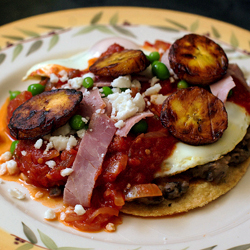 Two weekends ago, we ran into our friend Jeanne at the farmers market, as we often do. Jeanne had just returned from an East Coast trip, so we had a lot of catching up to do. But after chatting in the summer sun for a while, Cameron and I started to get antsy: We had to get home to start curing pork belly, the first step in making a batch of homemade bacon. Hearing this, Jeanne mentioned she’d always wanted to make her own bacon, but didn’t have the space for a smoker. “We have a smoker you can borrow whenever you want,” we offered. “Or, you could just come over next weekend, and smoke some bacon with us.”
Two weekends ago, we ran into our friend Jeanne at the farmers market, as we often do. Jeanne had just returned from an East Coast trip, so we had a lot of catching up to do. But after chatting in the summer sun for a while, Cameron and I started to get antsy: We had to get home to start curing pork belly, the first step in making a batch of homemade bacon. Hearing this, Jeanne mentioned she’d always wanted to make her own bacon, but didn’t have the space for a smoker. “We have a smoker you can borrow whenever you want,” we offered. “Or, you could just come over next weekend, and smoke some bacon with us.”
Jeanne is nothing if not determined: When she discovered that none of the farmers market vendors had any pork belly left, she scoured the City for a piece, so she could cure her own batch at home. Knowing that Jeanne and Cameron share a devotion to the Red Sox, I set the bacon-smoking time so that we could all listen to the game together: 10am Sunday. With pork curing in two fridges and the schedule nailed down, our discussions turned to more important things: What should we make for brunch?
“What do you think about huevos motuleños?” asked Jeanne, linking to her own recipe for the classic Mexican egg plate. “I think your fondness of things Mexican equals mine!” (She knows us well — it took me all of 30 seconds to agree.)
So last Sunday, Jeanne arrived right at 10am, with a bundle of cured pork belly, a bottle of homemade hibiscus-lemongrass agua fresca, and a ripe plantain. After we’d loaded up the smoker and dialed in the temperature, we popped back into the kitchen to finish up our brunch. As the sauce warmed, I refried the beans and crisped the tostadas; Cameron fried three sets of over-easy eggs to perfection (all at the same time!); and Jeanne sauteed the plantains and poured tall glasses of delicious agua fresca. Everything came together at just the right time — amazing what you can make happen when three avid cooks share the work. And so, as the smell of applewood began wafting in from the backyard, we sat down to a colorful and delicious Mexican brunch.
Despite its international origins, our team effort made a perfect One Local Summer feast. With the exception of the fried plantains — I claim a brunch-guest exemption! — everything in our meal came from local sources. It took a little creativity (substituting a salty local feta for Mexcian queso fresco) and a few extra steps to keep things locavore-friendly; you could certainly simplify things by using canned black beans and store-bought tostada shells if you weren’t as set on having an all-local feast.
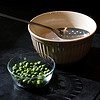
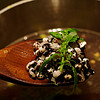
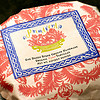


Huevos Motuleños
— adapted from World on a Plate
1-1/2 pounds ripe tomatoes
1 medium white onion, thinly sliced (divided use)
3 serrano chiles, cut into strips
—
1 ripe plantain, peeled and cut into 1/2-inch slices (optional)
2 cloves garlic, diced
1 to 2 cups black beans and their liquid
3 oz ham, cut into matchsticks or small dice
1/2 cup fresh peas, blanched or quick-braised
1 oz (about 1/4 cup) crumbled queso fresco or firm feta
8 eggs
4 corn tortillas
Roast the tomatoes on a rimmed baking sheet, 4 inches below a very hot broiler, until blistered and blackened, flipping to cook both sides. Cool tomatoes in a bowl, then peel while catching all the juices over the bowl. Coarsely puree the tomatoes and juice using a stick blender or in a food processor.
In a medium saucepan, heat 1T oil over medium heat. Add about 3/4 of the onion and saute, stirring regularly, until onions golden, about 8 minutes. Add the tomatoes and chile strips and simmer over medium-low heat for 15 minutes or so, stirring often, until the sauce is beginning to thicken but is still juicy. Season with salt to taste, and remove from heat to let the chiles steep.
(At this point, you can cool and refrigerate the sauce overnight.)
Pour a 1/2-inch depth of oil in a shallow skillet or frying pan. Warm the pan over medium heat until the oil shimmers. Add tortillas, one at a time, and cook until golden; flip with tongs and crisp the other side, then drain on a wire rack over newspaper or over a cookie sheet. Repeat with remaining tortillas until all are toasted.
Pour off most of the oil, reserving some (2T or so) for frying the beans, and leave about a tablespoon in the pan. Return to the heat, and lay the plantain slices in a single layer. Cook for 3 to 4 minutes per side until richly browned. Sprinkle with salt as soon as you take them out of the oil, then drain on paper towels and hold in a warm oven.
Add the reserved oil to the pan, and saute the remaining onions until golden and soft. Add the diced garlic and cook for another minute or two. Add the beans and a spoonful of their cooking liquid to the pan. Mash with a potato masher until beans are soft but some texture remains. Add more liquid as needed to achieve a spreadable texture, and keep warm, covered, over very low heat.
Mix together the ham strips and the peas in another small pan or dish, and warm gently over low heat. Crumble the cheese into a small bowl and set aside. Remove the chile strips from the tomato sauce, and set the pan of sauce over low heat to rewarm.
Finally, fry the eggs using your preferred method. (Traditionally, you want a runny yolk, so sunny-side up or over easy.) Spread some of the beans over each tostada, slide an egg on top, drizzle the tomato sauce over and around the eggs, letting it run off the tostada and on to the plate. Sprinkle each portion with the ham, peas and cheese. Serve immediately.
Farmers and food artisans who created the ingredients for this week’s meal: Bruins Farm
Bruins Farm, Winters: Tomatoes
Catalán Family Farm, Hollister: Onions
Chue’s Farm, Fresno: Serrano chiles & garlic
Rancho Gordo, Napa: Black beans
Boccalone, Oakland: Ham (proscuitto cotto)
Iacopi, Half Moon Bay: Shelling peas
Spring Hill Cheese Company, Petaluma: Goat feta
Eatwell Farm, Dixon: Pastured eggs
Primavera, Sonoma: Corn tortillas
Bariani, Sacramento: Olive oil
…plus our own homegrown
epazote for the beans
breakfast, locavore, Mexican, One Local Summer
4 Comments »




Posted by Anita on 06.21.09 8:31 PM
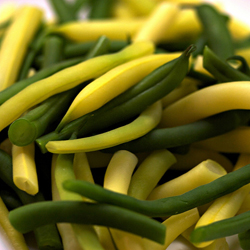 A few weeks ago, we headed down to Los Angeles for a quick getaway. Ostensibly, the occasion was our seventh(!) wedding anniversary, but truthfully the real purpose of our trip was to eat at all the places we’d been adding to our ever-expanding “must-try” list.
A few weeks ago, we headed down to Los Angeles for a quick getaway. Ostensibly, the occasion was our seventh(!) wedding anniversary, but truthfully the real purpose of our trip was to eat at all the places we’d been adding to our ever-expanding “must-try” list.
At the very top of said list was Pizzeria Mozza, the newish joint venture from Mario Batali and Nancy Silverton. After hearing rave reviews from pretty much every newspaper, magazine, blog, and friend, we decided to schedule Mozza in a prime Friday-night slot, to make sure we were getting the A-team of cooks and servers.
I won’t bore you with the litany of every thing that went wrong that night — we’re over the tedious exercise of writing negative restaurant reviews — but here’s the short version: Unexciting food, abysmal service, and pacing so unbelievably rushed that we were back in our car just 29 minutes after our first (and only) glass of wine hit the table. Seriously.
But every cloud has a silver lining. And at Mozza, that lining took the form of a fabulous melange of slender haricots verts, sweet shallots, crunchy hazelnuts, and creamy whole-grain mustard dressing (which, ahem, arrived in place of the roasted-cauliflower dish we’d actually ordered). Amid a menu of fair-to-decent dishes, this small plate stood out, and we quickly realized that we could easily duplicate it at home. We combed through every Batali and Silverton cookbook we own, but found nothing similar. However, Googling “beans + mustard + vinegar + hazelnuts” led us to a likely recipe — not from either of the Mozza chefs, but from Chef Dan Barber of New York’s Blue Hill restaurants.
Although we’re still a few weeks away from finding slim haricots at our market, their larger cousins are already becoming plentiful. And though hazelnuts aren’t grown in the Bay Area, we have plenty of other local options. We opted for walnuts, but made them a little more decadent by rubbing off their skins after toasting them lightly in a pan. After that, the rest of the dish comes together in a matter of a whisk here, a blanch there. And when served with a quick-brined pork chop and the first new potatoes of the year — as we did, for our One Local Summer meal this week — it makes for a great summer side-dish.


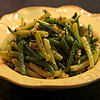
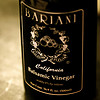

Summer Beans in Grainy Mustard Vinaigrette
— adapted from Dan Barber
1 T finely chopped shallots
2 T balsamic vinegar
12 oz trimmed green and yellow-wax beans (about 4 cups)
1/2 T whole grain mustard
1/4 cup good-quality extra-virgin olive oil
1 T chopped chives
1 T plus 1/4 tsp salt
1/4 tsp freshly ground pepper
2 T blanched nuts (we used walnuts) toasted, peeled if desired, and coarsely chopped
Soak shallots in balsamic vinegar in a small bowl for 30 minutes; set aside for later use.
Fill a saucepan with 2 quarts of water and 1T salt; bring to a boil. Meanwhile, fill a large bowl with water and ice.
When water comes to a boil, add beans and cook until just tender, about 3 minutes. Drain quickly and shock beans in the ice-water bowl. When fully chilled, drain beans well, pat dry, and set aside.
Stir mustard into balsamic-soaked shallots. Gradually whisk in olive oil until blended. (If you’d like a creamier dressing, buzz with a stick blender until well emulsified.) Add the chives, 1/4 teaspoon salt, and pepper; stir until combined.
Toss dressing with beans and nuts until evenly coated; serve immediately.
Farmers and food artisans who created the ingredients for this week’s meal: Marin Sun Farms
Marin Sun Farms, Point Reyes: Pork chop
Fox Barrel, Fairfax: Hard cider (for brine)
Eatwell Farm, Dixon: New potatoes
Dirty Girl Produce, Santa Cruz: Shallots
Bariani, Sacramento: Olive oil and balsamic vinegar
Dwelley Farms, Brentwood: Green and wax beans
Boccalone, Oakland: Whole-grain mustard
Glashoff, Fairfield: Walnuts
…and our own
homegrown chives and homemade chicken stock
locavore, One Local Summer, recipes, restaurants, SoCal
12 Comments »




Posted by Anita on 06.13.09 8:34 PM
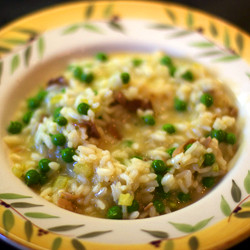 One of the greatest pleasures of growing your own food is standing next to your plot — preferrably while still in your pyjamas — and nibbling on the tenderest first bits of your harvest. I don’t think I’d be exaggerating if I said that Cameron and I probably ate a quarter of our shelling-pea crop in just that way. And even though it cut down dramatically on the number of peas that actually made it to the kitchen, I wouldn’t change a thing.
One of the greatest pleasures of growing your own food is standing next to your plot — preferrably while still in your pyjamas — and nibbling on the tenderest first bits of your harvest. I don’t think I’d be exaggerating if I said that Cameron and I probably ate a quarter of our shelling-pea crop in just that way. And even though it cut down dramatically on the number of peas that actually made it to the kitchen, I wouldn’t change a thing.
For this week’s One Local Summer meal, we enjoyed the last of our pea harvest in one of our favorite recipes, a risotto so deliciously savory that we’ve made it three times already this year. We’ve got another batch of peas already slinking their way up the trellis — courtesy of our mild summers, we get to enjoy spring crops nearly all year long — and already I am counting the days until we can make this simple supper again. Because although it’s fine with the regular farmers-market ingredients, it truly becomes its very best when made with tiny, super-sweet, just-picked baby peas.
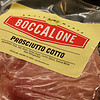
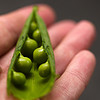
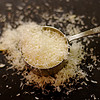

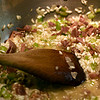
Risi e Bisi (Venetian Style Pea Risotto)
– adapted from Molto Italiano
2T extra-virgin olive oil
1 shallot, chopped
1 celery rib, chopped
1 oz prosciutto, cut into in 1/8-inch dice
3/4 cup Arborio or Carnaroli rice
1 quart chicken stock, warmed
1 cup shelled fresh peas
2T butter
1/4 cup grated hard cheese, such as dry Jack or Parmesan
salt and pepper
Heat the olive oil in a tall-sided 10-inch skillet or saucier pan. Saute the shallots, celery, and prosciutto over medium heat until soft, about 8 minutes. Add the rice and stir for 2 minutes, until the grains become opaque. Add enough stock to just cover the rice, and stir until stock is absorbed. Continue to add stock a ladleful at a time, waiting until most of the liquid is absorbed before adding the next bit. Taste the rice, and season with salt and pepper. Add peas and cook for 4 minutes, until peas are just tender. Remove from heat, add butter and cheese, and stir until just melted. Serve in warmed shallow bowls.
Farmers and food artisans who created the ingredients for this week’s meal: Bariani
Bariani, Sacramento: Olive oil
Dirty Girl Produce, Santa Cruz: Shallots
Catalán Family Farm, Hollister: Celery
Boccalone, Oakland: Proscuitto cotto
Lundberg Family Farms, Richvale: Eco-farmed white Arborio rice
Spring Hill Cheese Company, Petaluma: Butter and Dry Jack cheese…plus our own homemade chicken stock, made from
Marin Sun Farms and
Soul Food Farm chicken bones and our own homegrown English shelling peas
locavore, One Local Summer, recipes
9 Comments »




Posted by Anita on 06.03.09 6:19 PM
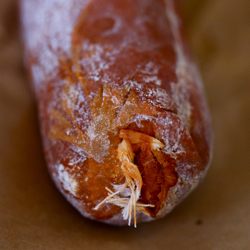 I first read about ‘nduja — a red-hot Italian meat paste that’s pronounced “en-DOO-ya” — in Saveur magazine, ages ago. Despite being the sort of foodstuff that’s right up my alley (hello, chiles and pork… together?!), I never seemed to be able to put my hands on the stuff. We’d heard rumors of a stall at London’s Borough Market selling ‘nduja, but our travels there never seemed to line up with their production. It seemed we’d have to make a trip to Calabria for the real thing, or go without.
I first read about ‘nduja — a red-hot Italian meat paste that’s pronounced “en-DOO-ya” — in Saveur magazine, ages ago. Despite being the sort of foodstuff that’s right up my alley (hello, chiles and pork… together?!), I never seemed to be able to put my hands on the stuff. We’d heard rumors of a stall at London’s Borough Market selling ‘nduja, but our travels there never seemed to line up with their production. It seemed we’d have to make a trip to Calabria for the real thing, or go without.
All that changed last month, with the introduction of locally made ‘nduja from Chris Cosentino’s Boccalone Artisan Meats. This spicy, spreadable salami’s quickly become the darling of the Bay Area carnivores, complete with an adorable nickname and mouth-watering coverage in all the hip spots.
But as delicious as it is when simply spread on a slice of baguette or a cracker, it seemed sacrilegious to snarf down such a long-sough treasure as an appetizer. Searching for other options, I came up with Gina DePalma’s very loose recollection of an ‘nduja-centric pasta dish she whipped up in her Roman kitchen. Despite not being much of a recipe — it lacked both measurements and timing cues — our first attempt at reproducing it turned out incredibly well, if I do say so myself. (You don’t have to take my word for it: Our friend Matthew, a former restaurant critic for the Seattle Times, pronounced it “as good as anything I had in a restaurant” during his visit to San Francisco.)
Now, I’m not sure I’d pick this humble pasta over an evening at SPQR or Contigo, but the dish was far more delicious than the effort it took to whip together. We nearly always have some dried pasta and a frozen container of leftover beans in the freezer; if I just keep a package of ‘nduja around, we’ll never lack a quick, weeknight supper.
The hardest part of the recipe may be getting your hands on the ‘nduja, which isn’t hard at all if you live in or near San Francisco: They sell it at the Boccalone Salumeria at the Ferry Building. For those of you farther afield, there’s always mail order (or a trip to Calabria?). Once you get your hands on the necessary ingredients, free to wing it with the ratios, just as we did. With such flavorful ingredients, I’m sure it’ll be just as good.
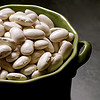
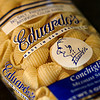
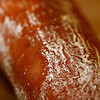
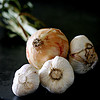
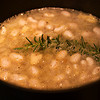
Pasta e Fagioli with ‘Nduja
– adapted from Gina DePalma
1 cup dry white beans
1 small onion, diced
olive oil
1 sprig rosemary
1 bay leaf
salt and pepper, to taste
1 carrot, peeled (if needed) and diced
1 stalk celery, chopped
2 cloves garlic, minced coarsely
4 oz (1/2 chub) cured ‘nduja, broken into chunks
8 oz dry small pasta, such as shells or ditalini
more olive oil, for garnish
hard Italian-style grating cheese, such as Pecorino
Soak the beans in enough water to cover by double their height, overnight if possible. When beans are soaked, heat a medium saucepan over medium-low heat; saute the onion in a good amount of olive oil until soft but not brown. Add the beans, their soaking liquid, rosemary, and bay. Bring to a hard boil for a few minutes, then reduce heat to a gentle simmer and cook until beans are beginning to become tender, but still firm. (This will take anywhere from 45 minutes to 3 hours, depending on the age of your beans and the length of their soaking.) Add the salt and pepper to taste, and simmer for another 10 to 15 minutes. At this point, you can discard the herbs and cool the beans in their liquid for later use.
When ready to bring the dish together: If you’ve made the beans ahead, gently warm them in their liquid in a small saucepan. Cook the pasta, stopping a minute or two before the cooking time on the package; drain and set aside. Meanwhile, heat a large skillet and add 2T olive oil. Saute the carrots and celery until soft; add the garlic and saute another minute. Add the ‘nduja, pressing to break it up and melt it as it heats. Add the beans and a small amount of their cooking liquid to the ‘nduja pan, along with the cooked pasta. If the mixture is dry, add more bean liquid until it’s wet; simmer a few minutes to allow the flavors to come together.
Divide the pasta into two or three warmed bowls. Drizzle with olive oil and top with shredded cheese.

This recipe is our entry for the inaugural week of
One Local Summer 2009, hosted by
Farm to Philly, with Western Region posts graciously recapped by
Columbus Foodie. Just like
last year, we’ll be exploring and honoring the foods from our local farmers and producers with at least one meal each week made from 100% local ingredients. We’re not declaring any exemptions this time — other than salt and spices — and our radius will be 100 miles.
Farmers and food artisans who created the ingredients for this week’s meal:
Iacopi, Half Moon Bay: Italian butter beans
Catalán Family Farm, Hollister: Onions
Bariani, Sacramento: Olive oil
Star Route, Bolinas: Carrots
Chue’s Farm, Fresno: Celery and garlic
Boccalone, Oakland: ‘Nduja
Eduardo’s, San Francisco: Pasta shells
Joe Matos, Santa Rosa: St. George cheese
….plus rosemary and bay leaf from our garden
cooking, locavore, meat, One Local Summer, recipes
11 Comments »




 Two weekends ago, we ran into our friend Jeanne at the farmers market, as we often do. Jeanne had just returned from an East Coast trip, so we had a lot of catching up to do. But after chatting in the summer sun for a while, Cameron and I started to get antsy: We had to get home to start curing pork belly, the first step in making a batch of homemade bacon. Hearing this, Jeanne mentioned she’d always wanted to make her own bacon, but didn’t have the space for a smoker. “We have a smoker you can borrow whenever you want,” we offered. “Or, you could just come over next weekend, and smoke some bacon with us.”
Two weekends ago, we ran into our friend Jeanne at the farmers market, as we often do. Jeanne had just returned from an East Coast trip, so we had a lot of catching up to do. But after chatting in the summer sun for a while, Cameron and I started to get antsy: We had to get home to start curing pork belly, the first step in making a batch of homemade bacon. Hearing this, Jeanne mentioned she’d always wanted to make her own bacon, but didn’t have the space for a smoker. “We have a smoker you can borrow whenever you want,” we offered. “Or, you could just come over next weekend, and smoke some bacon with us.”


























